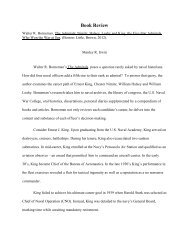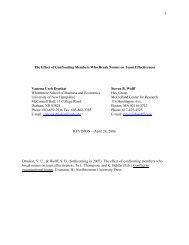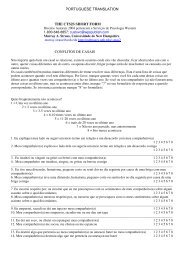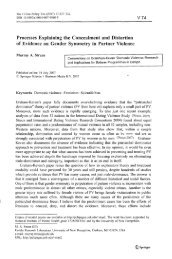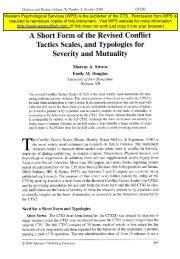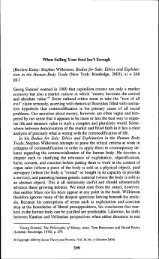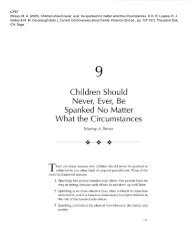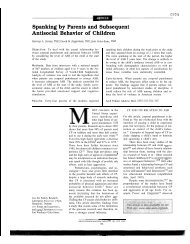Should the use of corporal punishment by parents be ... - UNH IT
Should the use of corporal punishment by parents be ... - UNH IT
Should the use of corporal punishment by parents be ... - UNH IT
Create successful ePaper yourself
Turn your PDF publications into a flip-book with our unique Google optimized e-Paper software.
Reprinted from Debatinp: Children's Lives: Current<br />
Xontroversies on Children and Adolescents, edited<strong>by</strong> Mary Ann<br />
Mason and Eileen Gambrill. Thousand Oaks, CA:Sage<br />
Publications, 1994.<br />
<strong>Should</strong> <strong>the</strong> <strong>use</strong> <strong>of</strong> <strong>corporal</strong> <strong>punishment</strong> <strong>by</strong> <strong>parents</strong> <strong>be</strong><br />
xmsidered child ab<strong>use</strong>?<br />
ED<strong>IT</strong>ORS’ NOTE: Corporal <strong>punishment</strong> (i.e.. any hitting <strong>of</strong> children, in any<br />
form) is common in this country as well as in many o<strong>the</strong>rs. Is it a form <strong>of</strong> ab<strong>use</strong>,<br />
or is it a necessary option for <strong>parents</strong> to <strong>use</strong> in socializing <strong>the</strong>ir children? Is<br />
it <strong>the</strong> reflection <strong>of</strong> cultural differences in pareming practices lhat should <strong>be</strong><br />
rcspectcd? In Ihis debate, Iwo aulhors provide arguments against considering<br />
<strong>corporal</strong> <strong>punishment</strong> child ab<strong>use</strong>, one an academic and one <strong>the</strong> director <strong>of</strong> an<br />
organization called <strong>the</strong> Ccnler for Affirmarivc Parenting.<br />
Murray A. Straw. Ph.D.. says YES. He is Pr<strong>of</strong>essor <strong>of</strong> Sociology and Co-Director<br />
<strong>of</strong> <strong>the</strong> Family Research Laboralory at rhe Universily <strong>of</strong> New Hampshire. He has<br />
served as presidenl <strong>of</strong> <strong>the</strong> National Council on Family Relations (1972-1973). <strong>the</strong><br />
Sociely for <strong>the</strong> Study <strong>of</strong> Social Problems (1988-1989), and rhe Eastern Sociological<br />
Society (199Gl99 I). In 1977, he received <strong>the</strong> Ernest W. Burgess Award <strong>of</strong> <strong>the</strong> National<br />
Council <strong>of</strong> Family Relations for outslanding research on [he family. He is <strong>the</strong> author<br />
<strong>of</strong> many articles and author or coauthor <strong>of</strong> 15 books, including <strong>the</strong> Nond,!~ook o/<br />
Family Measuremer~r Techiques (3rd ed.. 1990) and Pl~ysical Kolence III American<br />
Families (1990). He is currendy writing a book on <strong>corporal</strong> <strong>punishment</strong> titled<br />
Beaning /Ire Devil Our <strong>of</strong> T/rem: Corpowl Purtisltrtrer~r in American Favrilies.<br />
Ro<strong>be</strong>rt E. Larzelere. Ph.D., argues NO. He is Director <strong>of</strong> Residential Research at<br />
Boys Town, where he is doing resesch 011 treatment <strong>of</strong> childhood sex ab<strong>use</strong> victims and<br />
on paremat discipline. He is <strong>the</strong> author <strong>of</strong> <strong>the</strong> methodology chapter in T/w Non&ook<br />
o/Marriuge rmd /he Fwn;/y and has published I7 articles in a variety <strong>of</strong> social<br />
scienrific journals.<br />
John K. Rosemond also argues NO. He is a family psychologist and Director <strong>of</strong> <strong>the</strong><br />
Center for AffIrmalive Parenting in Gastonia, No& Carolina. He is <strong>the</strong> author <strong>of</strong> /o/m<br />
Roxemond k Six-Point Plan for Raising Happy. Heul~hy Clrildren. Ending tile Home-<br />
work Hassle and Parent Power!
Corporal <strong>punishment</strong> is <strong>the</strong> <strong>use</strong> <strong>of</strong>physical force with <strong>the</strong> intention <strong>of</strong>causing<br />
a child to experience pain but not injury, for purposes <strong>of</strong> correction or control<br />
<strong>of</strong> <strong>the</strong> child’s <strong>be</strong>havior. The most frequent forms are spanking, slapping, grab-<br />
bing or shoving a child “roughly” (i.e., with more force than is needed IO<br />
move <strong>the</strong> child), and hitting with certain traditionally acceptable objects such<br />
as a hairbrush, <strong>be</strong>lt. ruler. or paddle. Such acts <strong>by</strong> parcnls are legal and con-<br />
sidcrcd morally correct cvcrywhcrc in <strong>the</strong> United States. In a 1986 National<br />
Opinion Research Center survey <strong>of</strong> persons age I8 and over, 84% agreed with<br />
<strong>the</strong> statement “It is sometimes necessary to give a child a good hard spank-<br />
ing.” Between 90% and 100% <strong>of</strong> <strong>parents</strong> have actually <strong>use</strong>d corpoml punish-<br />
ment (Wauchopc & Straus. 1990).<br />
Oic way to answer <strong>the</strong> cpxtion <strong>of</strong> whclhcr ii cCd;liu lypc 0T p;mnt bCfl;lViOr<br />
is abusive <strong>use</strong>s <strong>the</strong> criterion <strong>of</strong> whe<strong>the</strong>r <strong>the</strong> <strong>be</strong>havior puts <strong>the</strong> child at risk <strong>of</strong><br />
injury (ei<strong>the</strong>r physical or psychological) that is greater than <strong>the</strong> risk <strong>of</strong> alterna-<br />
tive modes <strong>of</strong> child rearing. That criterion will <strong>be</strong> <strong>use</strong>d in this argument.<br />
It is well known that physical “ab<strong>use</strong>” (i.e., physical force that ca<strong>use</strong>s<br />
injury or has a high probability <strong>of</strong> causing injury) also tends to ca<strong>use</strong> serious<br />
psychological problems and increases <strong>the</strong> probability <strong>of</strong> juvenile delinquency.<br />
It is also well recognized that when ab<strong>use</strong>d children grow up, <strong>the</strong>y are more<br />
likely than those who wcrc not ab<strong>use</strong>d to ab<strong>use</strong> children physically and to<br />
engage in crime (Elmer & Gregg, 1967; Widom, 1989; Wolfe, 1987), even<br />
though such outcomes are far from inevitable. However, one almost never<br />
hears about <strong>the</strong> research showing that ordinary and legal <strong>corporal</strong> punish-<br />
mcnt <strong>of</strong> a mis<strong>be</strong>having child has <strong>the</strong> same consequences as physical ab<strong>use</strong>,<br />
even though not as strong. One reason <strong>the</strong>se fmdings are not accepted is that<br />
<strong>the</strong>y imply that almost all American <strong>parents</strong> are guilty <strong>of</strong> ab<strong>use</strong>, including<br />
those who write books <strong>of</strong> advice for <strong>parents</strong> and child psychology textbooks.<br />
So it is no wonder that <strong>the</strong> existence <strong>of</strong> research showing <strong>the</strong> harmful effects<br />
<strong>of</strong> spanking is one <strong>of</strong> <strong>the</strong> <strong>be</strong>st-kept secrets <strong>of</strong> American child psychology.<br />
The evidence linking <strong>corporal</strong> <strong>punishment</strong> to aggression comes from many<br />
different studies (Lefkowitz, Eron, Waldcr, & Huesmann, 1977; Maurer, 1974;<br />
Parke & Sla<strong>by</strong>, 1983; Straus, 1991). The evidence linking <strong>corporal</strong> punish-<br />
ment with o<strong>the</strong>r psychological problems comes from analyses <strong>of</strong> <strong>the</strong> 2,143<br />
families in <strong>the</strong> First National Family Violence Survey (Straus, Gelles, &<br />
Steinmetz, 1980) and 6,002 families in <strong>the</strong> Second National Family Violence<br />
Survey (Straus & Gcllcs, 1990). Both surveys found that close IO 100% <strong>of</strong>
198 CHILD ABUSE AND NEGLECT JSSUES<br />
<strong>parents</strong> <strong>of</strong> toddlers and half <strong>of</strong> <strong>parents</strong> <strong>of</strong> early teenage children <strong>use</strong>d <strong>corporal</strong><br />
<strong>punishment</strong> with <strong>the</strong>ir children. About <strong>the</strong> same proportion reported that <strong>the</strong>y<br />
<strong>the</strong>mselves were hit <strong>by</strong> <strong>the</strong>ir <strong>parents</strong> when <strong>the</strong>y wet-c adolescents.<br />
These high rates <strong>of</strong> hitting adolescents indicate <strong>the</strong> pcrvasivcncss <strong>of</strong> <strong>corporal</strong><br />
<strong>punishment</strong> in <strong>the</strong> rcating <strong>of</strong> American children. They arc also important<br />
<strong>be</strong>ca<strong>use</strong> some <strong>of</strong> <strong>the</strong> research findings arc based on whcthcr <strong>the</strong> children were<br />
hit <strong>by</strong> <strong>parents</strong> when <strong>the</strong>y were adolescents. As that is <strong>the</strong> majority <strong>of</strong> American<br />
children, those findings cannot <strong>be</strong> dismissed as representing only a small<br />
group <strong>of</strong> exceptional cases. Moreover, <strong>the</strong> findings from <strong>the</strong>se two surveys<br />
are based on analyses that controlled statistically for possible overlap <strong>of</strong> <strong>corporal</strong><br />
<strong>punishment</strong> with <strong>the</strong> age and socioeconomic status <strong>of</strong> <strong>the</strong> <strong>parents</strong>. <strong>the</strong> gender<br />
<strong>of</strong> <strong>the</strong> parent and <strong>the</strong> child, whe<strong>the</strong>r <strong>the</strong> patents explained what <strong>the</strong>y were<br />
doing, and whe<strong>the</strong>r <strong>the</strong>re was also violence <strong>be</strong>tween <strong>the</strong> <strong>parents</strong>.<br />
Corporal Punishment Increases<br />
Aggression and Delinquency<br />
The survey that asked about whe<strong>the</strong>r children sometimes need “a good hard<br />
spanking” also asked if spanking would <strong>be</strong> appropriate in three situations.<br />
For a child’s not cleaning up his or her room, only 9% felt that spanking was<br />
appropriate. For stealing something, <strong>the</strong> figure went up to 27%. For hitting<br />
ano<strong>the</strong>r child, it was 41%. If <strong>the</strong> survey had asked about hitting a parent, <strong>the</strong><br />
percentage might have reached 90%.<br />
There is a double message in <strong>the</strong>se statistics. On <strong>the</strong> one hand. <strong>the</strong> <strong>parents</strong><br />
are saying that hitting ano<strong>the</strong>r person is a terrible thing to do. On <strong>the</strong> o<strong>the</strong>r<br />
hand, <strong>the</strong>y are also saying <strong>by</strong> exmnple that when someone does something that<br />
is clearly wrong, it is morally correct to hit. The child learns both messages,<br />
and <strong>the</strong>n has toapply both principles. When <strong>the</strong>child applies those principles<br />
it is likely to produce an increase in that chiid’s hitting o<strong>the</strong>r children. This<br />
is <strong>be</strong>ca<strong>use</strong> children usually hit o<strong>the</strong>r children precisely <strong>be</strong>ca<strong>use</strong> fhey are<br />
doing something that is clearly wrong, such as taking toys orthrowing water<br />
at someone <strong>the</strong>y shouldn’t.<br />
Corporal <strong>punishment</strong> <strong>the</strong>refore teaches <strong>the</strong> morality <strong>of</strong> hitting. But that<br />
lesson is only one part <strong>of</strong> <strong>the</strong> “hidden curriculum” that accompanies each <strong>use</strong><br />
<strong>of</strong> <strong>corporal</strong> <strong>punishment</strong>. Ano<strong>the</strong>r key element <strong>of</strong> <strong>the</strong> hidden ourrirulum is<br />
that “those who love you are those who hit you.” This is <strong>be</strong>ca<strong>use</strong> virtually<br />
<strong>the</strong> only adults who hit infants and toddlers are those <strong>the</strong>y love most-<strong>the</strong>ir<br />
<strong>parents</strong>. This creates <strong>the</strong> confusion,<strong>of</strong> love and violence that is such a pernicious<br />
aspect <strong>of</strong> relationships <strong>be</strong>tween men and women. it also implicitly teaches
Probability<br />
<strong>of</strong> Wife .3<br />
Assault<br />
Figure 12.1. Probability <strong>of</strong> Wife Assauh <strong>by</strong> Physical Punishment During Teen Years ,,<br />
that it is morally acceptable IO hit those you love when <strong>the</strong>y “do wrong.” The<br />
trouble with ~hcsc parts <strong>of</strong> <strong>the</strong> hidden curriculum is that <strong>the</strong>y are almost a<br />
recipe for violence <strong>be</strong>tween spo<strong>use</strong>s la\cr in life, bccausc, sooner or later, almost<br />
all spo<strong>use</strong>s “do wrong” and “won’t listen to reason,” as <strong>the</strong> o<strong>the</strong>r spo<strong>use</strong> sees<br />
it. The results can <strong>be</strong> seen in Figure 12.1. It shows that <strong>the</strong> more <strong>corporal</strong><br />
<strong>punishment</strong> individuals experienced as children, <strong>the</strong> greater <strong>the</strong> percentage<br />
who, only a few years later in life. hit <strong>the</strong>ir spo<strong>use</strong>s. Figure 12.1 also shows that<br />
<strong>the</strong> increased risk <strong>of</strong> marital violence occurs among both those whose <strong>parents</strong><br />
were violent to each o<strong>the</strong>r (upper line) and those whose <strong>parents</strong> were not (upper<br />
line). These findings help explain <strong>the</strong> high rate <strong>of</strong> violence <strong>be</strong>tween couples<br />
found in many recent studies (Gcllcs & Straus. 1988; Straus & Gelles, 1990).<br />
Figure 12.2 shows that <strong>the</strong> more physical <strong>punishment</strong> individuals experi-<br />
enced as children, <strong>the</strong> greater <strong>the</strong> proportion who, as adults, went <strong>be</strong>yond<br />
ordinary <strong>corporal</strong> <strong>punishment</strong> and attacked <strong>the</strong>ir children severely enough<br />
for it to bc considcrcd child ab<strong>use</strong>. The two plot lines in Figure 12.2 show<br />
that this occurs rcgardlcss <strong>of</strong> whe<strong>the</strong>r <strong>the</strong>re was also violence <strong>be</strong>tween <strong>the</strong><br />
zl,ll pamNs. Relationships similar to those in Figure 12.1 were also found <strong>be</strong>tween<br />
<strong>corporal</strong> <strong>punishment</strong> and delinquency, and <strong>be</strong>tween <strong>corporal</strong> <strong>punishment</strong> and<br />
assaults on people o<strong>the</strong>r than family mcmbcrs (Straus, 1991 ).
200<br />
Probability<br />
<strong>of</strong> Child<br />
Ab<strong>use</strong><br />
.5 -<br />
.4 -<br />
.3 -<br />
.2 -<br />
CHILD ABUSE AND NEGLECT ISSUES<br />
.1 ,<br />
1<br />
I I I I I , I<br />
None Once Twice 3-5 6-9 IO-19 20-29 w +<br />
Physical Punishment During Teen knr5<br />
Figure 12.2. Probability <strong>of</strong> Child Ab<strong>use</strong> <strong>by</strong> Physical Punishment During Teen Years<br />
Drinking Problems, Depression, and Suicide<br />
In a recent study, a colleague and I analyzed physical <strong>punishment</strong> while<br />
holding constant <strong>the</strong> effects <strong>of</strong>o<strong>the</strong>r variables that might <strong>be</strong> <strong>the</strong> real explanation<br />
for <strong>the</strong> seeming adverse effects (Straus & Kaufman Kantor, 1992). We found<br />
that regardless <strong>of</strong> whe<strong>the</strong>r <strong>the</strong>re was marital violence, for men as well as<br />
women, and for persons <strong>of</strong> both low and high socioeconomic status, <strong>the</strong> more<br />
<strong>corporal</strong> <strong>punishment</strong> experienced in <strong>the</strong> teen years, <strong>the</strong> higher <strong>the</strong> percentage<br />
who have a drinking problem (Figure 12.3), <strong>the</strong> higher <strong>the</strong> percentage who<br />
have depressivesymptoms, and <strong>the</strong> higher <strong>the</strong> percentage who thought about<br />
killing <strong>the</strong>mselves during <strong>the</strong> 12 months prior to <strong>the</strong> time <strong>the</strong>y were inter-<br />
viewed (Figure 12.4).<br />
Corporal Punishment Is a Risk Factor<br />
It would <strong>be</strong> a mistake to think that <strong>the</strong> findings illustrated in Figures 12.1- 12.4<br />
show that <strong>corporal</strong> <strong>punishment</strong> inevitably leads to aggression, drinking prob-<br />
lems, suicide, and so on. That co,@d hardly <strong>be</strong> <strong>the</strong> case, or <strong>the</strong> human race<br />
would not have survived. Instead <strong>of</strong> a one-to-one causal relationship. corpo-<br />
ral <strong>punishment</strong> is what epidemiologists call a “risk factor.” A war is an example
.4 -<br />
Probability<br />
<strong>of</strong> Alcohol .3 _<br />
Ab<strong>use</strong><br />
.2 -<br />
.I- ,<br />
WOlTWn<br />
I , 1 I I I I ,<br />
None Once Twice 3-5 6-9 IO-19 20-29 30+<br />
Physical Punishment During Tern Ywrs<br />
Figure 12.3. Probability <strong>of</strong> Alcohol Ab<strong>use</strong> <strong>by</strong> Physicel Punishment During Teen Years<br />
35<br />
.3<br />
25<br />
Probability<br />
<strong>of</strong> Thinking<br />
.2<br />
About<br />
Suicide .I5<br />
.I<br />
.05<br />
None<br />
1 I 1 I 1 , 6<br />
1<br />
Once Twice 3-5 6-9 IO-19 20-29 30 +<br />
Physical Punishment During Teen Years<br />
Figure 12.4. Probability <strong>of</strong> Thinking About Suicide <strong>by</strong> Physical Punishment During<br />
Teen Years<br />
<strong>of</strong> zt risk factor. 11 increases Ihc risk <strong>of</strong> <strong>be</strong>ing killed, but cvcn in countries that<br />
suffcrcd millions <strong>of</strong> casunl~ics in World War II, only a small percentage <strong>of</strong><br />
\
202 CHILD ABUSE AND NEGLECT ISSUES<br />
<strong>the</strong> population were killed. Heavy smoking (a pack a day or more) is a risk<br />
factor. It increases <strong>the</strong> risk <strong>of</strong> dying<strong>of</strong> lung cancer 34 times, but despilc that,<br />
two-thirds <strong>of</strong> those who smoke this much do OO! die <strong>of</strong> any smoking-related<br />
diseases (Mattson, Pollack, & Cullen, 1987). Corporal <strong>punishment</strong> is also a risk<br />
factor. Like most pack-a-day smokers, most children who arc hit <strong>by</strong> <strong>parents</strong><br />
will experience few or no long-term problems, but <strong>the</strong> proportion who do is<br />
1.8 to 3.9 times greater, depending on <strong>the</strong> type <strong>of</strong> problem.<br />
‘Spanking Is Not Necessary<br />
By and large, <strong>parents</strong> do no1 like IO hit children. They do so <strong>be</strong>caust: <strong>the</strong>y<br />
want to produce well-<strong>be</strong>haved children and adults. So it is ironic and lragic<br />
that using <strong>corporal</strong> <strong>punishment</strong> to deal with immediate problems irlcrecfses<br />
<strong>the</strong> probability that <strong>the</strong> child will ultimately engage in dclinqucnl and criminal<br />
acts, have a drinking problem, <strong>be</strong>come depressed or suicidal, and so on. Morc-<br />
over, research now under way shows a num<strong>be</strong>r <strong>of</strong> o<strong>the</strong>r adverse effects that.<br />
<strong>be</strong>ca<strong>use</strong> <strong>of</strong> space limitations, cannot <strong>be</strong> discussed in this chapter, including<br />
an increased probability <strong>of</strong> drug <strong>use</strong>, alienation, and iowcred occupational<br />
and economic achievement.<br />
There is no need to expose our children to <strong>the</strong>se risks for <strong>the</strong> sake <strong>of</strong> <strong>the</strong><br />
immediate control that <strong>corporal</strong> <strong>punishment</strong> seems IO provide, bccausc <strong>the</strong><br />
evidence is that <strong>corporal</strong> <strong>punishment</strong> is not more effective than alternative<br />
modes <strong>of</strong> dealing with mis<strong>be</strong>havior. There is an almost limitless list <strong>of</strong> alterna-<br />
tives, such as expressing outrage at <strong>the</strong> mis<strong>be</strong>havior, explaining, time-out,<br />
removing <strong>the</strong> child from <strong>the</strong> situation, denying privileges, and refusing to<br />
continue an activity unless <strong>the</strong> child corrects his or her <strong>be</strong>havior.<br />
Spanking <strong>Should</strong> Be Illegal<br />
The laws <strong>of</strong> every state permit <strong>parents</strong> to <strong>use</strong> <strong>corporal</strong> purlishment. and <strong>the</strong><br />
informal cultural norms verge 011 requiring it “when necessary.“This cultural<br />
norm should <strong>be</strong> replaced <strong>by</strong> orle that says that a child should ~rcver <strong>be</strong> hit.<br />
Those are <strong>the</strong> rules for employees and even prisoners. We owe our children<br />
and ourselves nothing less. That has <strong>be</strong>en <strong>the</strong> law in Sweden since 1979, atld<br />
several o<strong>the</strong>r countries have followed that lead. If a Swedish parent dots <strong>use</strong> ’<br />
<strong>corporal</strong> <strong>punishment</strong>, he or she is no1 punished. Instead, ~hc transgression is<br />
taken as evidence that <strong>the</strong> parent is,having trouble manag ing <strong>the</strong> child and<br />
needs help, and <strong>the</strong> help is provided.‘
There are signs that o<strong>the</strong>r industrial nations are moving IO outlaw corporai<br />
<strong>punishment</strong>. Many long-run <strong>be</strong>nefits are likely IO accrue when this happens<br />
in <strong>the</strong> United States. For <strong>parents</strong> it will mean, on average, less hassle in bringing<br />
up children; it should also result in <strong>be</strong>tter-<strong>be</strong>haved children. For children it<br />
will mean less’risk<strong>of</strong> <strong>be</strong>ing physically ab<strong>use</strong>d and less risk <strong>of</strong> <strong>be</strong>ing delinquent.<br />
.,L For <strong>the</strong> next generation <strong>of</strong> Americans it will mean less wife <strong>be</strong>ating. “street<br />
” crime,” drug and alcohol ab<strong>use</strong>, and depression and suicide, and greater<br />
occupationa!and economic achievcment.,For American society, bringing up<br />
children without any USC <strong>of</strong> <strong>corporal</strong> <strong>punishment</strong> is likely to result in less<br />
rnoncy <strong>be</strong>ing expended on frcatmcnt for lhc many social and psychological<br />
problems that ~hc USC <strong>of</strong> <strong>corporal</strong> <strong>punishment</strong> cngcndcrs; <strong>the</strong> nation will,,ke<br />
healthier, less violent, and wealthier.<br />
References
204 CHILD ABUSE AND NEGLECT ISSUES<br />
Some <strong>corporal</strong> <strong>punishment</strong> <strong>use</strong>d <strong>by</strong> <strong>parents</strong> is clearly abusive, as evidenced<br />
<strong>by</strong> unacceptable rates <strong>of</strong> physical child ab<strong>use</strong> in our society (Straus & Gellcs,<br />
1986). The controversial aspect <strong>of</strong> this issue concerns whe<strong>the</strong>r all <strong>corporal</strong><br />
<strong>punishment</strong> <strong>by</strong> <strong>parents</strong> should also <strong>be</strong> considered abusive. Beca<strong>use</strong> <strong>of</strong> <strong>the</strong><br />
high rates <strong>of</strong> child ab<strong>use</strong>, several advocates are pushing an Eighteenth Amend-<br />
ment type <strong>of</strong> approach to its prevention. Just as that amendment failed IO stop<br />
alcohol ab<strong>use</strong>, <strong>the</strong> available evidence suggests that a blanket prohibition <strong>of</strong><br />
all parental spanking would also <strong>be</strong> countcrproductivc. an overly simplistic<br />
solution to <strong>the</strong> child ab<strong>use</strong> problem.<br />
An alternative preventive approach is to clarify <strong>the</strong> distinctions <strong>be</strong>tween<br />
abusive and <strong>be</strong>neficial forms <strong>of</strong> <strong>corporal</strong> <strong>punishment</strong>. The available data,<br />
though sketchy, indicate that parental spanking is generally bcncficial to <strong>the</strong><br />
child at least under <strong>the</strong> following conditions:<br />
I. Spanking is limited to a maximum <strong>of</strong> two slaps IO <strong>the</strong> buttocks with an open hand.<br />
2. The child is <strong>be</strong>tween ages 2 and 6.<br />
3. Spanking is <strong>use</strong>d to supplement positive parenting, not to replace it.<br />
4. Spanking is <strong>use</strong>d primarily IO back up less aversive discipline responses, such<br />
as verbal correction or time-out.<br />
Behavioral parent training programs have done an excellent job <strong>of</strong> docu-<br />
menting <strong>the</strong>ir own effectiveness for reducing children’s <strong>be</strong>havior problems.<br />
These programs include a time-out discipline response to targeted mis<strong>be</strong>hav-<br />
ior. Most <strong>be</strong>havioral programs for children from ages 2 to about 10 also<br />
prescri<strong>be</strong> a detailed spanking procedure to <strong>be</strong> <strong>use</strong>d only for noncompliance<br />
with time-out. For example, Forehand and McMahon (1981) specify:<br />
The parent is <strong>the</strong>n instmcted what to do if <strong>the</strong> child decides IO leave time out while<br />
it is still in force. The child should <strong>be</strong> immediately returned to <strong>the</strong> chair. The<br />
first time this ever occurs, <strong>the</strong> parent states, “If you get <strong>of</strong>f <strong>the</strong> chair again, I will<br />
spank you.” This warning is only presented once. . . If <strong>the</strong> child gets <strong>of</strong>f <strong>the</strong><br />
chair again, <strong>the</strong> parent returns <strong>the</strong> child to <strong>the</strong> time out area. She or he <strong>the</strong>n<br />
administers two (and only two) spanks on <strong>the</strong> child’s bottom with an open hand.<br />
(pp. 79-80)<br />
They go on lo say, “While we are basically opposed to physical punish-<br />
ment, we have found a mild spanking to <strong>be</strong> <strong>the</strong> most feasibie backup for <strong>the</strong>
co~pOd Punishmen! <strong>by</strong> I’urflJrW 205<br />
child leaving <strong>the</strong> time OUT chair” (p. 80). ReSc=rch has shown that Such a<br />
backup procedure improves <strong>the</strong> effectiveness *f time-out (Bean & Ro<strong>be</strong>rts,<br />
1981). Fur<strong>the</strong>r, <strong>the</strong> only alternative backup procedure that has done as well<br />
at improving time-out compliance is <strong>the</strong> “barri er” method, which could <strong>be</strong><br />
considered even more avers ive than a mild span king (Day & Ro<strong>be</strong>rts, 1983;<br />
Ro<strong>be</strong>rts, 1988; Ro<strong>be</strong>rts &! Powers. 1990). lt involves using a barrier (e.g., a<br />
a-foot-high plywood sheet) to Prevent a child from escaping <strong>the</strong> time-out<br />
room. O<strong>the</strong>r backups, such as a holding procedure (Ro<strong>be</strong>rts &Powers, 1990)<br />
and response cost (McMahon & wells, l990),work significantly less effec-<br />
tively, O<strong>the</strong>r <strong>be</strong>havioral parent training programs for children under 9 years<br />
<strong>of</strong> age also explicitly prescri<strong>be</strong> a mild spanking 10 enforce time-out compii-<br />
ante (e.g., Barkley, 1987; Dangel & Polster. 1984).<br />
A second line <strong>of</strong> research has found that a combination <strong>of</strong> <strong>punishment</strong> and<br />
reasoning delays <strong>the</strong> next nCsbchavior recurrcncc in toddlers significantly<br />
longer than dots <strong>punishment</strong> alonc. reason@ alone, or o<strong>the</strong>r discipline re-<br />
sponscs (Larzclere, in press; Larzclcre & Schneider, 1991). This holds true<br />
for both <strong>corporal</strong> and nOllCOrpOra~ PunishmeIlt and for both fighting and<br />
diso<strong>be</strong>djcncc. The combination <strong>of</strong> <strong>punishment</strong> and reasoning was found to<br />
reduce <strong>the</strong> subsequent probability <strong>of</strong> a fighring recurrence <strong>by</strong> 32% and a<br />
diso<strong>be</strong>dience recurrence <strong>by</strong> 16%. The only response that was as effective aS<br />
a combination <strong>of</strong> reasoning and <strong>corporal</strong> <strong>punishment</strong> was a combination <strong>of</strong><br />
non<strong>corporal</strong> <strong>punishment</strong> and reasoning. The latter combination was equally<br />
effective for fighting incidents and SligW bat not significantly more effcc-<br />
tive for diso<strong>be</strong>dience incidents (Larzelere &Schneider, 1991).<br />
A fur<strong>the</strong>r advantage <strong>of</strong> pairing reasoning with <strong>punishment</strong> during <strong>the</strong><br />
toddler years is that it increases <strong>the</strong> effectiveness <strong>of</strong> reasoning alone. Sa<strong>the</strong>r<br />
(1992) found that reasoning alone delays <strong>the</strong> next mis<strong>be</strong>havior recurrence<br />
longer to <strong>the</strong> extent it had <strong>be</strong>en reCentlY combined with <strong>punishment</strong>. This<br />
increased effectiveness Of a reasoning-alone response occurred whe<strong>the</strong>r <strong>the</strong><br />
recent backup consisted <strong>of</strong> <strong>corporal</strong> or non<strong>corporal</strong> <strong>punishment</strong>.<br />
Toge<strong>the</strong>r, <strong>the</strong>se results suggest <strong>the</strong> following view <strong>of</strong> optima) parental<br />
discipline responses: In <strong>the</strong> toddler Years. Parents should first respond with<br />
<strong>the</strong> least aversive discipline <strong>the</strong>y think will slop <strong>the</strong> mis<strong>be</strong>havior. If that does<br />
not elicit compliance, <strong>the</strong>y should <strong>the</strong>n turn to more aversiveresponses, Such<br />
as non<strong>corporal</strong> consequences (e.g., time-out). If <strong>the</strong> child still fails to comply<br />
with <strong>the</strong> non<strong>corporal</strong> consequences, such noncompliance <strong>Should</strong> result in a<br />
mild prescri<strong>be</strong>d spanking, patterned after Forehand and McMahon’S (1981)<br />
guidelines. Such a scqucncc will makcboth flonpunitivcdisciplinc rcsponscs<br />
(e.g., reasoning) and non<strong>corporal</strong> <strong>punishment</strong> (e.g., time-out) more effec;ive<br />
in achieving compliance later On. Consequently, <strong>parents</strong> will <strong>use</strong> such disci-<br />
pline responses more frequently and more effectively, and <strong>the</strong>y will thus <strong>use</strong>
206 CHILD ABUSE AND NEGLECT ISSUES<br />
more aversive responses less frequently as <strong>the</strong> child grows older. This dcvelop-<br />
mental pattern will lead to <strong>the</strong> effectiveness <strong>of</strong> non<strong>corporal</strong> <strong>punishment</strong> docu-<br />
mented <strong>by</strong> parent trainers and to <strong>the</strong> subsequent tendency for <strong>parents</strong> <strong>of</strong> well-<br />
<strong>be</strong>haved preadolescents to resort more frequently to reasoning alone than do<br />
o<strong>the</strong>r <strong>parents</strong> (H<strong>of</strong>fman, 1977).<br />
This view <strong>of</strong> parental discipline responses is consistent with o<strong>the</strong>r lines <strong>of</strong><br />
research. For example, Baumrind (1973) found authoritative parenting to <strong>be</strong><br />
associated with optimal child development, both in social responsibility and<br />
in individual initiative. According to Baumrind, authoritative parenting is<br />
characterized <strong>by</strong> firm control, high nurturance, and nonrestrictiveness. Authori-<br />
tative <strong>parents</strong> are as willing as authoritarian <strong>parents</strong> and more willing than<br />
permissive <strong>parents</strong> to <strong>use</strong> <strong>corporal</strong> <strong>punishment</strong> as part <strong>of</strong> <strong>the</strong>ir firm control.<br />
Baumrind concludes, “The evidence . . does not indicate that ncgativc rein-<br />
forcement or <strong>corporal</strong> <strong>punishment</strong> per se were harmful or incffcctivc procc-<br />
dures, but ra<strong>the</strong>r that <strong>the</strong> total pattern <strong>of</strong> parental control determined <strong>the</strong><br />
effects on <strong>the</strong> child <strong>of</strong> <strong>the</strong>se procedures” (p. 36).<br />
Many readers may bc asking, Utri whal about all lhc empirical cvidcncc<br />
against spanking? The major evidence against ordinary parental spanking is<br />
that its <strong>use</strong> correlates positively with antisocial aggression in children. In a<br />
review <strong>of</strong> <strong>the</strong> relevant literature, <strong>the</strong> average correlation was a meager .16,<br />
explaining only 3% <strong>of</strong> <strong>the</strong> variability in chiidrcn’s antisocial aggression<br />
(Steinmetz. 1979). Fur<strong>the</strong>r, some or all <strong>of</strong> that 3% may <strong>be</strong> accounted for <strong>by</strong><br />
<strong>the</strong> children’s effect on <strong>the</strong> <strong>parents</strong> instead <strong>of</strong> <strong>the</strong> <strong>parents</strong>’ effect on <strong>the</strong> children.<br />
In four longitudinal studies, only I <strong>of</strong> 26 tests showed a significant associa-<br />
tion <strong>be</strong>tween spanking and subsequent aggression. The average correlation<br />
<strong>be</strong>tween spanking at <strong>the</strong> first measurement occasion and antisocial aggrcs-<br />
sion at <strong>the</strong> second measurement occasion was .03 (Cham<strong>be</strong>rlin, 1978; Johan-<br />
nesson, 1974; Lefkowitz, Huesmann, & Eron. 1978; Sears, 1961).<br />
O<strong>the</strong>r evidence against <strong>the</strong> a ggression-modeling view <strong>of</strong> spanking is that<br />
<strong>the</strong> outlawing <strong>of</strong> all parental spanking in Sweden may have increased that<br />
country’s child ab<strong>use</strong> rate. Gelles and Edfeldt (1986) found that, one year<br />
after spanking <strong>by</strong> <strong>parents</strong> was abolished, <strong>the</strong> Swedish rag <strong>of</strong> child <strong>be</strong>ating<br />
or threatening to <strong>use</strong> or using a weapon against a child wasiwo to four times<br />
as large as <strong>the</strong> U.S. rate. However, <strong>the</strong>y report that this did not produce a<br />
significant difference on <strong>the</strong>ir indices <strong>of</strong> severe violence. (It probably would<br />
have <strong>be</strong>en significantly higher than ihc 1985 U.S. rate rcportcd in Straus &<br />
Gelles, 1986.) This high rate <strong>of</strong> child ab<strong>use</strong> is surprising, bccnusc Swcdcn is<br />
less violent than <strong>the</strong> United States on o<strong>the</strong>r measures. ForexampIc. <strong>the</strong> Swedish<br />
murder rate is less than half that <strong>of</strong> <strong>the</strong> United Stutcs. Fur<strong>the</strong>r, <strong>the</strong> antispank-<br />
ing law would supposedly suppress self-reports <strong>of</strong> child ab<strong>use</strong>, even phone<br />
reports made anonymously. So <strong>the</strong>re are several reasons to expect a lower
child ab<strong>use</strong> rate in Sweden than in <strong>the</strong> United Stales, and <strong>the</strong> effect <strong>of</strong> outlawing<br />
spanking is one <strong>of</strong> <strong>the</strong> few possible explanations for why it was so high in 1980.<br />
But what mechanism might lead to <strong>the</strong> paradoxical result that banning<br />
spanking would increase ra~cs <strong>of</strong> child ab<strong>use</strong>? We have little empirical evidence<br />
on this issue <strong>be</strong>ca<strong>use</strong> <strong>of</strong> IIIC widespread assumption that decreased spaqking<br />
would decrease child ab<strong>use</strong>. Baumrind (1973) does rcporl that permissive<br />
<strong>parents</strong>, who were <strong>the</strong> most antispanking <strong>of</strong> her three parenting groups, ad&ted<br />
more <strong>of</strong>ten to “explosive attacks <strong>of</strong> rage in which <strong>the</strong>y inflicted more pain<br />
or injury upon <strong>the</strong> child than <strong>the</strong>y had intended. . . . Permissive <strong>parents</strong><br />
apparently <strong>be</strong>came violent bccausc <strong>the</strong>y felt that <strong>the</strong>y could nei<strong>the</strong>r control<br />
<strong>the</strong> child’s <strong>be</strong>havior nor tolerate its effect upon <strong>the</strong>mselves” (p. 35). So it<br />
could <strong>be</strong> that a prohibition aga,inst all spanking eliminates <strong>the</strong> type <strong>of</strong> mild<br />
spanking that serves IO maintain control <strong>be</strong>fore a child’s mis<strong>be</strong>havior leads<br />
to an escalation into a cocrcivc cycle <strong>of</strong> violcncc (Patterson, 1 Y82). The USC<br />
<strong>of</strong> mild spanking as a backup for less avcrsivc discipline responses may<br />
subsequently make those less aversive responses more effective <strong>by</strong> lhcm-<br />
sclvcs, thcrc<strong>by</strong> climin;~ting lhc need for fur<strong>the</strong>r <strong>corporal</strong> <strong>punishment</strong>.<br />
Given <strong>the</strong> mcagcrncss <strong>of</strong> <strong>the</strong> data ag;lillst tnodcr;llc spanking:, lhc anti-<br />
spanking movcmcnt is in danger <strong>of</strong> <strong>be</strong>coming merely an attempt IO impost <strong>the</strong><br />
values <strong>of</strong>onc segment <strong>of</strong> society upon orhers. Well-educated social scientists<br />
tend to <strong>be</strong> highly verbal and thus to favor exclusively verbal solutions to<br />
intcrpcrsonal conflict <strong>of</strong> all kinds. To o<strong>the</strong>rs, howcvcr, actions may speak louder<br />
than words, a rcasonablc altcrnativc as long as those actions are not abusive.<br />
For example, one parent training program that <strong>use</strong>d lower socioeconomic<br />
groups <strong>of</strong> <strong>parents</strong> as an advisory committee in its development found that<br />
those <strong>parents</strong> advocated <strong>the</strong> inclusion <strong>of</strong> additional material about spanking<br />
in <strong>the</strong> program (Dangel & Polster, 1984). Asian immigrants who have tradition-<br />
ally included spanking as part <strong>of</strong> parental socialization but hear that spanking<br />
may result in <strong>the</strong>ir children <strong>be</strong>ing taken away from <strong>the</strong>m in <strong>the</strong> United States<br />
<strong>of</strong>ten end up abdicating <strong>the</strong>ir parental responsibility altoge<strong>the</strong>r (Thomas, 1992).<br />
At a minimum, some implementations <strong>of</strong> <strong>the</strong> current child ab<strong>use</strong> laws have<br />
<strong>be</strong>en insensitive to cultural differences (Thomas, 1992). and <strong>the</strong>se problems<br />
<strong>of</strong> cultural insensitivity may <strong>be</strong> increased if moderate forms <strong>of</strong> spanking also<br />
come to <strong>be</strong> considered abusive.<br />
In conclusion, <strong>the</strong> available evidence suggests that some moderate spank-<br />
ing <strong>of</strong> children from 2 to 6 years <strong>of</strong> age is effective, particularly as a backup<br />
10 less avcrsivc discipline responses such as reasoning and time-out. WC need<br />
more research if we arc IO bc able 10 distinguish fur<strong>the</strong>r bctwccn appropriate<br />
from inapproprialc <strong>use</strong>s <strong>of</strong> <strong>corporal</strong> <strong>punishment</strong>. Until we do our rcscarch<br />
homework on potentially <strong>be</strong>neficial spanking. it is premature to impose a guilt<br />
trip on Ihe VLSI majority <strong>of</strong> <strong>parents</strong> for ordinary spanking. Howcver:wc are
208 CHILD ABUSE AND NEGLECTISSUES<br />
in a position to suggest spanking guidelines IO <strong>parents</strong> who intend (0 include<br />
it in <strong>the</strong>ir discipline repertoire. II is conceivable that such an approach may<br />
do more to reduce ctifd ab<strong>use</strong> and o<strong>the</strong>r negative effects on children than would<br />
a premature call IO consider ail spanking ab<strong>use</strong> in order to abolish it.<br />
References<br />
Baumrind, D. (1973). The development <strong>of</strong> i~w’oo~en~~l competence lhroueh socialiwlion. In A.<br />
D. Pick (Ed.), Miurresorn Swposirr or1 C/ii/d J’syc-hology (Vol. 7, pp. 3.46). Minncqolis:<br />
University <strong>of</strong> Minnesorn Press.<br />
Be,=.“, A. W., g; Ro<strong>be</strong>rts. M. W. (1981). The effect <strong>of</strong> limeout release conliogencics on changes<br />
in child noncompliance. Jorrrunl <strong>of</strong>Alxtor~rtol Child Psy-l~olog): 9. 9S-10s.<br />
Cham<strong>be</strong>rlin, R. W. (1978). Rela[ionships <strong>be</strong>tween child-rearing styles and child <strong>be</strong>havior over<br />
time. Amrricm Jarrrrtrd <strong>of</strong> Disearrs cf Childw~~. 132. 155 160.<br />
Da,@, R. F., & P&w, R. A. (1984). Winning! A sysleln:llic. ewpiricat ;~ppronch (0 parem viii nio8,<br />
In R. F. Dangel & R. A. Polsler(Eds.). Porrrtr rwirrlr~g (pp. 162-201). New York: Coilford.<br />
Day. D. E., & Ro<strong>be</strong>rts. M. W. (1983). An analysis 01’Itlr physical punisbmenc coroponcnt <strong>of</strong> a<br />
pxent training program. Jo~rr~ol <strong>of</strong> A~IIO~III
210 CHILD ABUSE AND NEGLECT ISSUES<br />
Discussion (hah!) <strong>of</strong> this volatile topic generally <strong>be</strong>gins with someone asking,<br />
Do you <strong>be</strong>lieve in spanking children? Strange-as if spanking is some sort<br />
<strong>of</strong> religious principle or experience. There are some, in fact, who would have<br />
<strong>parents</strong> <strong>be</strong>lieve that <strong>by</strong> spanking children on a regular basis, <strong>the</strong>y are pleasing<br />
God and doing His (this is definitely a guy-God) will, but I am not one <strong>of</strong> those.<br />
Speaking for myself, spanking has never <strong>be</strong>en a religious experience. 1 do<br />
not <strong>be</strong>lieve that one spoils <strong>the</strong> child <strong>by</strong> sparing <strong>the</strong> rod, or switch, or <strong>be</strong>lt, or<br />
hand. But, true confession time, 1 have, on occasion, spanked my children.<br />
When <strong>the</strong>y were much younger, that is (<strong>the</strong>y’re both adults). And, in retie-<br />
spect, given <strong>the</strong> same situations and outrageous <strong>be</strong>haviors, I would probably<br />
do so again. I have no regrets. But I don’t Oelieve in spanking.<br />
I am not <strong>of</strong> an extremist persuasion on this issue. I issue that disclaimer<br />
realizing that <strong>by</strong> admitting I’ve taken an occasional hand (and only a hand,<br />
I assure you) to my children, 1 join. in <strong>the</strong> minds <strong>of</strong> some, <strong>the</strong> ranks <strong>of</strong> <strong>the</strong> vile.<br />
None<strong>the</strong>less, I do not bclievc that spankings arc ncccssat-y to <strong>the</strong> proper rearing<br />
<strong>of</strong> children. Nor do I <strong>be</strong>lieve that spankings arc, in and <strong>of</strong> thcmsclves, abusive.<br />
So, what do I <strong>be</strong>lieve? I <strong>be</strong>lieve that spankings arc a lousy form <strong>of</strong><br />
discipline. In fact, 1 <strong>be</strong>lieve <strong>the</strong>y do not warrant <strong>be</strong>ing classed as discipline<br />
at all. At <strong>be</strong>st, a spanking is nothing more. nothing less, than a dramatic form<br />
<strong>of</strong> nonverbal communication. It is a means <strong>of</strong> getting <strong>the</strong> attention <strong>of</strong> a child<br />
who needs to give that attention quickly; <strong>of</strong> terminating a <strong>be</strong>havior that is<br />
rapidly escalating out <strong>of</strong> control; <strong>of</strong> putting an exclamation point in front <strong>of</strong><br />
a message <strong>the</strong> child needs to hear.<br />
The spontaneously delivered (as in without warning) spank to <strong>the</strong> child’s<br />
rear end says, “Stop!” and “Now hear this!” Having terminated <strong>the</strong> <strong>be</strong>havior<br />
in question (a tantrum, for example), havin, = secured <strong>the</strong> child’s attention, it<br />
is necessary that <strong>the</strong> parent follow through with a consequence <strong>of</strong> one sort<br />
or ano<strong>the</strong>r. The spank is merely <strong>the</strong> prelude to <strong>the</strong> consequence. In <strong>the</strong> final<br />
analysis, <strong>the</strong> spank is, <strong>the</strong>refore, inconsequential. The follow-thrdbgh is what’s<br />
important. Without proper follow-through a spanking is, at <strong>the</strong> very least, stupid,<br />
The parent might send <strong>the</strong> child to his or her room for a time. or take away<br />
.a privilege for lhe rcmaindcr <strong>of</strong> lhc day, or simply give <strong>the</strong> child a stern<br />
reprimand. For <strong>the</strong> most part, and for <strong>the</strong> purposes <strong>of</strong> our discussion, <strong>the</strong> form<br />
<strong>the</strong> consequence takes is fairly arbitrary. All-important is that <strong>the</strong> spanking<br />
not <strong>be</strong> <strong>the</strong> consequence, <strong>the</strong> end ,in itself. When spankings arc trcntcd as an
end in and <strong>of</strong> thcmsclves, <strong>parents</strong> mis<strong>use</strong>, over<strong>use</strong>. and edge CVC~ CIOSC~ lo<br />
ab<strong>use</strong>. No doubt about it, spankings can <strong>be</strong> administered abusively.<br />
But. <strong>the</strong>n, banishing a child to his or her room can <strong>be</strong> done abusively. It<br />
would <strong>be</strong> abusive, for instance. to lock <strong>the</strong> child’s door and keep <strong>the</strong> child in<br />
confincmcnt for days. And one can reprimand a child about his <strong>of</strong> her<br />
mis<strong>be</strong>havior abusively. It would, for example, <strong>be</strong> abusive to refer IO <strong>the</strong> child<br />
as a “little shit.” But sending children to <strong>the</strong>ir rooms and reprimanding <strong>the</strong>m<br />
are not, in and <strong>of</strong> <strong>the</strong>mselves. abusive. Nor are spankings. But, in <strong>the</strong> wrong<br />
hands, <strong>the</strong>y can <strong>be</strong>.<br />
At this point, <strong>the</strong> naysayer is probably inclined to say, Given that <strong>the</strong>re’s<br />
no way <strong>of</strong> knowing in advance who will spank abusively and who will not,<br />
let’s just <strong>by</strong>pass <strong>the</strong> risk <strong>by</strong> making spanking illegal. The same argurncnt can<br />
<strong>be</strong> made for sending children to <strong>the</strong>ir rooms and talking to <strong>the</strong>m, thus it is<br />
absurd, rhetorical (as all <strong>the</strong> naysayer’s arguments will prove to <strong>be</strong>).<br />
The term corporr~l ,mr77isl7n7e77/ is problematic to this, uh, discussion<br />
<strong>be</strong>ca<strong>use</strong> a properly administcrcd spanking is not, strictly speaking, a punish-<br />
mcnt. Nor, for that matter, is a wrongly administcrcd spanking. According<br />
to <strong>the</strong> scientific definition, a <strong>punishment</strong> is ;I consequence that renders <strong>the</strong><br />
<strong>be</strong>havior that prcccdcd ir less likely to reoccur. But people who <strong>be</strong>lieve <strong>the</strong>y<br />
can spank certain <strong>be</strong>haviors out <strong>of</strong> cxistcncc arc going to discover othcrwisc.<br />
Their frustration is likely to drive <strong>the</strong>m to spank more <strong>of</strong>ten and harder.<br />
Almost inevitably. thcsc folks wind up spanking abusively. But it is impor-<br />
tant to understand fh;u thcsc arc not ncccssarily abusive people. Often,<br />
perhaps more <strong>of</strong>ten than not, lhese are people who want to do right <strong>by</strong> <strong>the</strong>ir<br />
children. The proper intervention here is education, not legislation.<br />
When I am asked, <strong>by</strong> <strong>the</strong> courts or social services, to counsel <strong>parents</strong> who<br />
have spanked a child or children abusively, I rarely waste time attempting to<br />
persuade <strong>the</strong>se folks IO stop spanking. Instead <strong>of</strong> trying to paddle back up<br />
<strong>the</strong> stream <strong>of</strong> <strong>the</strong>ir upbringing, 1 advise <strong>the</strong>m on how to spank sfraregically,<br />
as in occasionally, at carefully selected times. and only to secure <strong>the</strong> child’s<br />
attention. This has not won me friends at social services (where one can<br />
generally find one <strong>of</strong><strong>the</strong> largest concentration <strong>of</strong>emotionally charged zealots<br />
in <strong>the</strong> free world), but has definitely reduced recidivism among <strong>the</strong>se clients.<br />
It is appropriate, at this point, to define what, in my estimation, constitutes<br />
an appropriate manner <strong>of</strong> applying a spank to a child’s rear end. I <strong>be</strong>lieve (that<br />
word again) in spanking as a first resort; in spanking in anger; in spanking<br />
only with one’s hand; in spanking only <strong>the</strong> child’s rear end; in administering<br />
only one, certainly no more than IWO, spanks at a time, I also bclicve that <strong>the</strong><br />
more <strong>of</strong>ten one spanks, <strong>the</strong> less cffectivc <strong>the</strong> spankings will <strong>be</strong> at terminating<br />
undesirable <strong>be</strong>haviors and securing <strong>the</strong> child’s attention. In order to retain a
..,_~~<br />
212 CHILD ABUS E AND NEGLECT ISSUES<br />
spank’s effectiveness, <strong>parents</strong> must spankon Y once in <strong>the</strong> proverbial blue moon.<br />
Spank as a first resort? That’s ri&l. Spontaneously. As soon as you see<br />
(hat <strong>the</strong> child is losing control or as soen as <strong>the</strong> child commits whatever<br />
completely outrageous act (e.g., splttlng On an adult). Whack! “Now hear<br />
this!” Send <strong>the</strong> child to his room. Done. AS one builds up to a spanking with<br />
warning and threat, one builds frustration - When, under those “last resort”<br />
circumstances, <strong>the</strong> spanking finally comes. it is likely to consist <strong>of</strong> a whack,<br />
whack, whack. whack, whack, whack. whack,<br />
spankings <strong>be</strong>come ab<strong>use</strong>.<br />
whack, whack. That’s when<br />
Spank in anger? That’s right. If you’re going to spank a child’s rear end,<br />
it is rightful to make perfectly clear You d isapprove <strong>of</strong> <strong>the</strong> child’s <strong>be</strong>havior.<br />
YOU are displeased, as in angry. Not in a rage, however. You arc not in a rage<br />
<strong>be</strong>ca<strong>use</strong> you’ve spanked as a first resort. You<br />
10 conlnlunicate that emotion clearly.<br />
arc just angry, and you are able<br />
Add <strong>the</strong> hand only, not <strong>be</strong>lts, switches. spoons, or whatcvcr. Add IO <strong>the</strong><br />
child’s rear end only, not thighs, face, arrTT1.s. or whatever. Add once, may<strong>be</strong><br />
twice. Add <strong>the</strong> message and <strong>the</strong> consequertce, <strong>the</strong> follow-through, and you’ve<br />
got a properly administered spanking. gut I don’t <strong>be</strong>lieve in spanking. You<br />
can do without <strong>the</strong>m, if YOU choose.<br />
“So, <strong>the</strong>n, let’s do without <strong>the</strong>m!” No, i said JUU can do without <strong>the</strong>fts. You<br />
choose for you. (‘(1 Ch0W.e for me. YOct accept responsibility for your<br />
<strong>be</strong>havior, but do me <strong>the</strong> favor <strong>of</strong> not (WJlg to accept responsibility for mint,<br />
okay? I’ll handle that myself, thank YOU.<br />
You see, what really, ItIdY bo<strong>the</strong>rs ltle about <strong>the</strong> naysayers is <strong>the</strong>y think<br />
(hey know what’s <strong>be</strong>st for everyone. Beneath <strong>the</strong> veneer <strong>of</strong> social concern,<br />
<strong>the</strong>y’re pseudointellectual. potiticat(Y correct mcgalornaniacs. If you don’t<br />
agree with <strong>the</strong>m, <strong>the</strong>y want to pass laws that make you agree, or at least<br />
conform to <strong>the</strong>ir ideas <strong>of</strong> what constitutes appropriate <strong>be</strong>havior. They <strong>be</strong>lieve<br />
<strong>the</strong>y are ordained, <strong>by</strong> Virtue <strong>of</strong> moral sUpcriority, to create a perfect world,<br />
and have a right to impose that vision en us all, <strong>by</strong> whatever means ncccssary.<br />
They say spankings are abusive. Why? Beca<strong>use</strong> <strong>the</strong>y are acts <strong>of</strong> violence.<br />
1 say not necessarily. Spankings can <strong>be</strong> violent. On <strong>the</strong> o<strong>the</strong>r hand, spankings<br />
can simply <strong>be</strong> dramatic. But <strong>the</strong> naysayers’ swollen egos prevent acceptance<br />
<strong>of</strong> any o<strong>the</strong>r point <strong>of</strong> view. There is but one proper point <strong>of</strong> view. Theirs,<br />
They say that spankings teach children that violence is an acceptable<br />
means <strong>of</strong> responding 10 interpersonai conflict. This, <strong>the</strong>y assert, is “proven”<br />
<strong>by</strong> <strong>the</strong> “fact” that violent and/or abusive adults, almost IO tftc pcmxl, wcrc<br />
ab<strong>use</strong>d as children. Accepting <strong>the</strong> truth in <strong>the</strong> latter, it noncthclcss proves<br />
nothing about spanking. By assymiag, a priori, that spankings arc abusive,<br />
<strong>the</strong> argument ViOheS ollc <strong>of</strong> <strong>the</strong> PreccPtS <strong>of</strong>-rational inquiry. Fur<strong>the</strong>rmore, <strong>the</strong>
argument fails to cons ider <strong>the</strong> many, many, many people who were spanked<br />
as children (some, like myself, fairly <strong>of</strong>ten> who are not, as adults, violent<br />
or abusive. (I realize, however. Ihat <strong>by</strong> ad znifring I was spanked as a child<br />
and steak I spanked my children, I’ve “proven” <strong>the</strong>jr argument.)<br />
They wave research that “&arty proves” that spanking destroys self-esteem,<br />
promotes violent <strong>be</strong>havior, and so on. The research stinks. All <strong>of</strong> it. There is<br />
not one study into <strong>the</strong> effccls <strong>of</strong> spanking on children that’s worth <strong>the</strong> paper<br />
it’s written on. Every single one <strong>of</strong> <strong>the</strong>m (I’ve reviewed <strong>the</strong>m all, I think) js<br />
rife with design problems. This so-catted research would <strong>be</strong> ridiculed in a<br />
sophomore course in experimental psychology.<br />
tn <strong>the</strong> firs1 place, <strong>the</strong>m js no research that tracks chitdrcn who were<br />
spanked property as opposed 1o imt~ropcriy. To my knowtcdgc, that djstjnc-<br />
ljon has ncvcr <strong>be</strong>en r?ladc <strong>by</strong> any rcscarcher. That reveals something jmpor-<br />
lmt about many, if nol most, <strong>of</strong> ttlcse so-Cat ted researchers. They’re not doing<br />
rcscarch at all; They ’ re lrying to promote <strong>the</strong>ir own personal agendas. And<br />
<strong>the</strong>y cloak this promotion. this sh:nnetess propaganda effort, in <strong>the</strong> guise <strong>of</strong><br />
“science.”<br />
But as tong as we’ re talkjng lousy research, I’ll bring out some <strong>of</strong> my own.<br />
We’ll compare lousy research with lousy research. Thai way, we’ll stand on<br />
equal ground. My lousy research jnvotvcs me and my lwochi~ldrcn. As I said,<br />
t spanked <strong>the</strong>m. They’re fine, thank you. They’re achievement oriented, but<br />
not computsivcly so. They’re rcsponsibte, but do not take life seriously.<br />
,They’re gregarious. but not self-cenlcrcd. They’ve never given one indjca-<br />
tion <strong>of</strong> an inclination toward violence. They’re not perfect. They have <strong>the</strong>ir<br />
share <strong>of</strong> problems, as do we all, but nel big ones. Just typjcat ones, <strong>the</strong> ones<br />
that come wilh tack <strong>of</strong> expcricnce and marurjry. Therefore, <strong>the</strong> research-my<br />
resea&4jsproves all <strong>the</strong> o<strong>the</strong>r research. My research “clearly proves” <strong>the</strong>re<br />
js a proper way <strong>of</strong> spanking children Ihat is not abusive, that does not result<br />
jn damage 10 a child’s self-CsWem or significant emotional damage <strong>of</strong> any o<strong>the</strong>r<br />
description.<br />
When all is said and done, this argument isn’i about spanking, or <strong>corporal</strong><br />
pt.mishment. It’s about people. It’s about people who want lo create a perfect<br />
world. It’s about potjlics and political Correctness. It’s about people who want<br />
to impose <strong>the</strong>ir ideology on everyone. <strong>by</strong> hook or crook. And <strong>the</strong> more frustrated<br />
<strong>the</strong>y <strong>be</strong>come, <strong>the</strong> more oulrageous <strong>the</strong>y <strong>be</strong>come, <strong>the</strong> more dangerous <strong>the</strong>y<br />
<strong>be</strong>come. That’s <strong>the</strong> problem with moral superiority, in any form. Frustrated,<br />
jl inclines toward tolatitarianism.<br />
The problem wilh spanking js not spanking, it’s people. It’s a people problem<br />
that wilt not <strong>be</strong> solved lhrough legislation. It wilt. in fact, never <strong>be</strong> completely<br />
solved, only mitigalcd. t1 GlIl <strong>be</strong> mltlglrtcd throudh cducaljon. So, let’s <strong>be</strong>gin
214 CHILD AUUSE AND NEGLECT ISSUES I 1<br />
<strong>the</strong> education, keeping in mind that <strong>the</strong> <strong>be</strong>st, most effective educators, <strong>the</strong> j<br />
ones who ca<strong>use</strong> people to truly want to listen, inquire, and learn, don’t<br />
promote extremist points <strong>of</strong> view.
I’ve come to <strong>the</strong> conclusion that this debate is more about politics than it is<br />
about psychology. The hidden agenda is <strong>the</strong> desire on <strong>the</strong> part <strong>of</strong> a vocal<br />
minority within my pr<strong>of</strong>ession and related fields to write social policy and<br />
<strong>the</strong>re<strong>by</strong> impose <strong>the</strong>ir vision <strong>of</strong> a perfect world upon <strong>the</strong> rest <strong>of</strong> us.<br />
Everyone would agree that at some poinf a spanking does indeed <strong>be</strong>come<br />
ab<strong>use</strong>. Likcwisc. a reprimand, at some point, <strong>be</strong>comes ab<strong>use</strong>. According to <strong>the</strong><br />
logic <strong>of</strong> <strong>the</strong> antispanking argument, thcrcforc, we should ban <strong>the</strong> <strong>use</strong> <strong>of</strong> all<br />
“negative language” when addressing children. Or, <strong>be</strong>ca<strong>use</strong> confining a child<br />
to his or her room puts <strong>the</strong> child at greater risk for claustrophobia, <strong>parents</strong><br />
should <strong>be</strong> prohibited, <strong>by</strong> law, from exercising this “riskier” form <strong>of</strong> disci-<br />
plinc. If you think <strong>the</strong>se arc absurd parodies <strong>of</strong> <strong>the</strong> antispanking mentality,<br />
you are naive. Let mc assure you that we are talking abour folks who, ifgivcn<br />
an inch in <strong>the</strong> social policy realm, will want a mile.<br />
WC are IO bclievc spanking has a “hidden curriculum” that teaches chil-<br />
dren, first, that hitting is morally acccptablc and, second. “those who love<br />
you, hit you.” Antispankers cannot, <strong>of</strong> course, prove any <strong>of</strong> this. The rhetoric<br />
<strong>of</strong> <strong>the</strong> argument is emotionally seductive (which is, after all, <strong>the</strong> point <strong>of</strong><br />
rhetoric), but in <strong>the</strong> final analysis it is nothing more than undiluted psy-<br />
chobabblc-a construcrion <strong>of</strong> language, not <strong>of</strong> fact.<br />
On <strong>the</strong> matter <strong>of</strong> studies that demonstrate a correlation <strong>be</strong>tween spanking<br />
and <strong>the</strong> later ab<strong>use</strong> <strong>of</strong> wives, children. and self, it should <strong>be</strong> noted that <strong>the</strong>se<br />
studies---cl/l <strong>of</strong> <strong>the</strong>m-arc characterized <strong>by</strong> design problems so obvious and<br />
pervasive as to send a graduate student <strong>of</strong> experimental methods into gales<br />
<strong>of</strong> laughter. For one thing, <strong>the</strong> self-reports <strong>of</strong> people who have run afoul <strong>of</strong><br />
authorities <strong>be</strong>ca<strong>use</strong> <strong>of</strong> such problems can hardly <strong>be</strong> relied upon. For ano<strong>the</strong>r,<br />
correlation is no1 ca<strong>use</strong>. For ano<strong>the</strong>r, as every text on experimental methods<br />
will tell you, ex post facto investigations are next to worthless. For yet ano<strong>the</strong>r,<br />
<strong>the</strong> authors <strong>of</strong> such studies cannot <strong>be</strong> acc<strong>use</strong>d <strong>of</strong> objectivity. In o<strong>the</strong>r words,<br />
despite <strong>the</strong> impressive bibliography, this isn’t science. What we have here is<br />
a shrewd attempt on <strong>the</strong> part <strong>of</strong> social policy activists within <strong>the</strong> pr<strong>of</strong>essional<br />
community to <strong>use</strong> psychobabble and pseudoscience as <strong>the</strong> basis for law.<br />
.I<br />
According to <strong>the</strong> politically correct argument, a hand laid to a child’s rear<br />
“‘. end is ab<strong>use</strong>. Americans are engaged in mass denial <strong>of</strong> this “fact.” Only <strong>the</strong><br />
chosen few see through <strong>the</strong> wail <strong>of</strong> denial. As <strong>the</strong> rest <strong>of</strong> us are unwilling to<br />
admit our error. <strong>the</strong> only option is lo pass laws that turn <strong>the</strong> average parent<br />
into a criminal. Not to worry, howcvcr, <strong>be</strong>ca<strong>use</strong> <strong>of</strong>fending <strong>parents</strong> won’t <strong>be</strong>
216 CHILD ABUSE AND NEGLECT ISSUES<br />
punished. They will <strong>be</strong> given “help.” And who, pray tell, will provide this<br />
help? Why “helpin g prOfeSSiOnah” <strong>of</strong> course. So <strong>the</strong> hidden agenda is not<br />
just political, but economic as well.<br />
we are told that antispanking l~s will transform us into a “hcalthicr, 1~s~<br />
violent, and wealthier” society. In truth, such laws will only line <strong>the</strong> pockets<br />
<strong>of</strong> desperately codependent pr<strong>of</strong>essionals whose lust for powcr and need lo<br />
“help” people kno w no bounds.<br />
i<br />
:
Hcrc and elscwhcrc, M urray Straus provides <strong>be</strong>tter data IO support <strong>the</strong> blanket<br />
antispanking position than do o<strong>the</strong>r advocates for that position. The juxta-<br />
position <strong>of</strong> his data and mine suggests some important differences <strong>be</strong>tween<br />
potentially abusive and <strong>be</strong>neficial <strong>use</strong>s <strong>of</strong> <strong>corporal</strong> <strong>punishment</strong>. The most<br />
relevant distinctions seem IO depend upon <strong>the</strong> age <strong>of</strong> <strong>the</strong> child, <strong>the</strong> intensity<br />
<strong>of</strong> spanking. whcthcr err not spanking is <strong>use</strong>d in combination with reasoning,<br />
and whcthcr or not spanking is <strong>use</strong>d to back up less avcrsivc discipline<br />
responses.<br />
He also suggests an importanl hypo<strong>the</strong>sis about <strong>the</strong> hidden curriculum <strong>of</strong><br />
<strong>corporal</strong> <strong>punishment</strong>: Does it teach people to hit <strong>the</strong> ones <strong>the</strong>y love? It will <strong>be</strong><br />
important to get adequate data on this hypo<strong>the</strong>sis and to determine whe<strong>the</strong>r<br />
this hidden curriculum applies to all parental <strong>use</strong>s <strong>of</strong> <strong>corporal</strong> <strong>punishment</strong> or<br />
to some types more than o<strong>the</strong>rs.<br />
Straus’s data do show that <strong>the</strong> frcqucncy <strong>of</strong> parental spanking <strong>of</strong> teenagers<br />
is at least a marker variable for increased risk <strong>of</strong> a wide variety <strong>of</strong> negative<br />
outcomes. The crucial question is whe<strong>the</strong>r such <strong>corporal</strong> <strong>punishment</strong> is a causal<br />
or noncausal marker variable. For example. <strong>be</strong>ing in a hospital would <strong>be</strong> a<br />
marker variable indicating an incrcascd risk <strong>of</strong> dying. That does not imply,<br />
howcvcr. that WC can reduce prcmaturc deaths <strong>by</strong> eliminating hospitals.<br />
Instead, hospitalization is a noncausal marker variable indicating that some-<br />
thing is medically wrong, which in turn increases <strong>the</strong> risk <strong>of</strong> death. Straus<br />
has shown that frcqucntly spanked teenagers arc at increased risk for negative<br />
outcomes, but <strong>the</strong> data do not yet indicate whet hcrspanking itself increases that<br />
risk or whe<strong>the</strong>r it is a noncausal marker variable. It might merely reflect <strong>the</strong><br />
level <strong>of</strong> menage antisocial <strong>be</strong>havior or a breakdown in <strong>the</strong> parent&child<br />
relationship. This <strong>by</strong> no means justifies parental spanking <strong>of</strong> teenagers, but<br />
simply points out that <strong>the</strong> current data do not conclusively support even a<br />
blanket prohibition <strong>of</strong> parenlal spanking <strong>of</strong> icenagers.<br />
The evidence is clear that mild parental spanking is <strong>be</strong>neficial for <strong>the</strong> child<br />
under certain circumstances al least <strong>be</strong>tween ages 2 and 6. Straus provides a<br />
list <strong>of</strong> alternative discipline responses. but <strong>the</strong> effectiveness <strong>of</strong> <strong>the</strong> most<br />
important alternatives (cxptanation andfimc-out) has <strong>be</strong>en shown to improve<br />
after <strong>be</strong>ing backed up with a mild spanking. This suggests that many nonspank-<br />
ing <strong>parents</strong> <strong>of</strong> well-<strong>be</strong>haved teenage children may have arrived at that point<br />
<strong>by</strong> shaping <strong>the</strong> effectiveness <strong>of</strong> nonspanking discipline responses with a
218 CHILD ABUSE AND NEGLECT ISSUES<br />
mild-spanking backup in earlier years. Such an optimal pattern <strong>of</strong> discipline<br />
responses should not <strong>be</strong> undermined <strong>by</strong> a premature conclusion that all<br />
spanking is abusive.
Response to Larzelere<br />
Although I admire <strong>the</strong> care and scientific skill with which Ro<strong>be</strong>rt Larzelere<br />
has investigated this critically important issue. I would like to present here<br />
some critical points on which we disagree.<br />
Lartclcrc writes as though lhc sole issue is whcthcr <strong>corporal</strong> <strong>punishment</strong><br />
is cffcctive in correcting mis<strong>be</strong>havior. But that is only one <strong>of</strong> <strong>the</strong> issues. Just<br />
as important arc <strong>the</strong> harmful side effects, such as increased risk <strong>of</strong> <strong>the</strong> child<br />
using those same methods later in life to correct <strong>the</strong> mis<strong>be</strong>havior <strong>of</strong> a spo<strong>use</strong>,<br />
increased risk <strong>of</strong> depression and suicide, and <strong>the</strong> danger that what starts out<br />
as ordinary <strong>corporal</strong> <strong>punishment</strong> can cscalatc into physical ab<strong>use</strong>. The last<br />
<strong>of</strong> thcsc is notjust a thcorctical possibility; research <strong>by</strong> Kadushin and Martin<br />
(1981) shows that it is typical <strong>of</strong> <strong>the</strong> majority <strong>of</strong> physical ab<strong>use</strong> cases.<br />
Even if, for <strong>the</strong> rnomcnt, WC restrict <strong>the</strong> discussion to whcthcr spanking is<br />
effective in correcting mis<strong>be</strong>havior. <strong>the</strong> studies cited <strong>by</strong> Larzelerc and llis<br />
own research found that “a combination <strong>of</strong> no,l<strong>corporal</strong> <strong>punishment</strong> and<br />
reasoning” was as effective as <strong>corporal</strong> <strong>punishment</strong> (emphasis added). Given<br />
that <strong>the</strong> <strong>be</strong>st that can <strong>be</strong> said for spanking is that it is just as effective as<br />
non<strong>corporal</strong> <strong>punishment</strong>, why risk <strong>the</strong> possibility <strong>of</strong> harmful side effects <strong>by</strong><br />
using <strong>corporal</strong> <strong>punishment</strong>?<br />
The issue is not whe<strong>the</strong>r <strong>punishment</strong> should ever <strong>be</strong> <strong>use</strong>d. Even informing<br />
a child that what he or she has done wrong has a <strong>punishment</strong> element, <strong>be</strong>ca<strong>use</strong><br />
that information is painful. This approach <strong>the</strong>refore combines <strong>punishment</strong><br />
with information. I agree with Larzelcre when he says that “<strong>parents</strong> should<br />
first respond with <strong>the</strong> least aversive discipline <strong>the</strong>y think will stop <strong>the</strong> mis-<br />
<strong>be</strong>havior.” However, I disagree that spanking should ever <strong>be</strong> one <strong>of</strong> <strong>the</strong> punish-<br />
ments <strong>use</strong>d when less aversive steps do not work.<br />
Larzelere cites an excellent study <strong>by</strong> Baumrind, but <strong>the</strong> children <strong>of</strong><br />
Baumrind’s “authoritntivc”porcrlts arcsocially rcsponsiblc and self-dircctcd<br />
<strong>be</strong>ca<strong>use</strong> <strong>the</strong>ir <strong>parents</strong> <strong>use</strong> a combination <strong>of</strong> firm control. love, and nonrcstric-<br />
tivcness, not <strong>the</strong> fact lhat <strong>the</strong>se <strong>parents</strong> also <strong>use</strong>d <strong>corporal</strong> <strong>punishment</strong> occasion-<br />
ally. My hypo<strong>the</strong>sis is that if those <strong>parents</strong> had <strong>be</strong>en equally firm, loving,<br />
and nonrestrictive, but left out <strong>the</strong> <strong>corporal</strong> <strong>punishment</strong>, <strong>the</strong>y would have<br />
<strong>be</strong>en even more effective in producing responsible and self-directed children.<br />
Gelles and Edfeldt’s (1986) study <strong>of</strong> <strong>the</strong> Swedish law banning <strong>corporal</strong><br />
<strong>punishment</strong> cannot <strong>be</strong> <strong>use</strong>d to evaluate that law. The study was done only a
220 CHILD ABUSE ANDNEGLECTISSUES<br />
yea after<strong>the</strong> law was passed, and that is tooshort a time for it IO have had much<br />
effect. Even if <strong>the</strong> study had <strong>be</strong>en done 5 or 10 years af~cr. it would 1101<br />
provide data on whe<strong>the</strong>r <strong>the</strong> law reduced <strong>corporal</strong> <strong>punishment</strong> and physical<br />
ab<strong>use</strong>, <strong>be</strong>ca<strong>use</strong> <strong>the</strong> rates in existence <strong>be</strong>fore <strong>the</strong> law was passed arc unknown.<br />
I agree that nonspanking would <strong>be</strong> a disaster if <strong>parents</strong> were IO lake this<br />
to mean <strong>be</strong>ing permissive regarding children’s mis<strong>be</strong>havior. Children do<br />
need firm but loving control, as in Baumrind’s authoritative group. But<br />
spanking is not needed to achieve this. Some <strong>parents</strong>, if denied <strong>the</strong> oppor~u-<br />
nity to spank, will “give up” 011 trying tocorrccl misbchuvior. but nly guess<br />
is that <strong>the</strong>se <strong>parents</strong> would <strong>be</strong> very fcv+‘, <strong>be</strong>ca<strong>use</strong> most ~~I~CIIIS xc deeply<br />
committed to producing responsible chikircn. A more likely dnngcr is that<br />
efforts to correct mis<strong>be</strong>havior will shift from physical aggression (spanking)<br />
to verbal aggression (atrcmpts to C3USC psychological pain <strong>by</strong> insulting or<br />
depreciating <strong>the</strong> worth <strong>of</strong> <strong>the</strong> child). Thut would truly <strong>be</strong> disastrous, <strong>be</strong>ca<strong>use</strong><br />
psychological attacks have even inore harmful effects than do physical<br />
attacks (Vissing, S~raus, Gelles, 8~ Hnrrop, 199 I). Conscqucntly. educational<br />
programs to end <strong>corporal</strong> puriishment must give equal weight IO ending<br />
verbal attacks on children. Such progralns are also necdcd for <strong>parents</strong> who<br />
spank, <strong>be</strong>ca<strong>use</strong> my research shows that <strong>parents</strong> who spank <strong>the</strong> most also tend<br />
to <strong>use</strong> <strong>the</strong> most verbal aggression.<br />
Response IO Rosemond<br />
I agree with Rosemond’s view that “without proper follow-through a spank-<br />
ing is. stupid.” But I also disagree will1 him; in my opinion, what Roscmond<br />
thinks <strong>of</strong> as “follow-through” (such as sending <strong>the</strong> child to his or her room,<br />
taking away a privilege, or administering a stern reprimand) should <strong>be</strong> <strong>the</strong><br />
fiirsr step, not a follow-up. In mOSt Cases, such sleps alone will do <strong>the</strong> job.<br />
A related issue concerns Rosemond’s advice “to spank strotegic~~/!,: as in<br />
occasionally, at carefully selected times.” Thc~problem is that hc contradicts<br />
himself <strong>by</strong> repeated advice to “spank first” (e.g., three paragraphs earlier)<br />
and advice to <strong>use</strong> “spanking as a first resorl” (<strong>the</strong> following paragraph). How<br />
limited and strategic can it <strong>be</strong> if every mis<strong>be</strong>havior isJirsr dealt with <strong>by</strong> “a<br />
spank to <strong>the</strong> child’s rear end”? 1 think that Rosemond does genuinely want<br />
<strong>parents</strong> to <strong>use</strong> spanking only rarely, but his advice to do it as a first resort<br />
almost guarantees <strong>the</strong>y will do it frequently, with all <strong>the</strong> adverse effects that<br />
he himself notes.<br />
I readily admit to starling from <strong>the</strong> assumption that spanking is “abusive,”<br />
just as Rosemond starts from <strong>the</strong> opposite assumption. The difference <strong>be</strong>-<br />
tween scientists, such as Ro<strong>be</strong>rt Larzelere and myself, and <strong>the</strong> “zealots” and
“pseudoinrcllcc:ual, politically correct megalomaniacs” (who are well illus-<br />
Irated <strong>by</strong> John Rosemond!) is that scientists test <strong>the</strong>ir assumplions and are<br />
willing IO ICI <strong>the</strong> findings <strong>of</strong> scientific tests have <strong>the</strong> fast word. My research<br />
was designed IO give <strong>the</strong> assumpIion that all spanking is abusive a chance to<br />
<strong>be</strong> ei<strong>the</strong>r supported or disproved. Unfortunately for prospanking zealots such<br />
as John Roscmond, <strong>the</strong> research found that spanking is associated with harmful<br />
side cffecfs. For various technical reasons, we cannot <strong>be</strong> sure this proves that<br />
spanking ca<strong>use</strong>s thcsc problems, but we can <strong>be</strong> sure that <strong>the</strong> assumed harmful<br />
effects $f spanking wcrc given Ihc opportunity to bc disproved buI wcrc WI.<br />
Rosemond acc<strong>use</strong>s rcscarchcrs <strong>of</strong> shameless propaganda efforts in <strong>the</strong><br />
name <strong>of</strong> science. 1 acc<strong>use</strong> him <strong>of</strong> just plain shameless propaganda. Hc <strong>use</strong>s<br />
Ihc Iypical propagandist 1001s <strong>of</strong> Ihc “big lit” and inflammalory language.<br />
He seems IO Ihink that <strong>the</strong> rcscarch can <strong>be</strong> dismissed <strong>by</strong> calling it “lousy”<br />
and saying that it “stinks.”<br />
Moreover, Roscmond’s idea <strong>of</strong> evidence is to cite <strong>the</strong> example <strong>of</strong> his<br />
children and himself-both were spanked and both are okay. Smokers <strong>use</strong>d<br />
to make a similar argument; now, howcvcr, WC know that heavy smoking<br />
increases <strong>the</strong> risk <strong>of</strong> deaIh from lung cancer and o<strong>the</strong>r smoking-related diseases<br />
34 times. But <strong>be</strong>ca<strong>use</strong> “only” a third <strong>of</strong> heavy smokers die from it, two-thirds<br />
can say, “i’ve smoked more than a pack a day all my life and I’m okay,“just<br />
as Rosemond can say that he spanked his children and <strong>the</strong>y’re okay.<br />
Response to Both<br />
Although Larzelcrc would not put it that way, both he and Rosemond think<br />
<strong>the</strong> previous research Winks.” Some does. buI much is excellent, including<br />
<strong>the</strong> study <strong>by</strong> Larzelere himself, which shows IhaI <strong>corporal</strong> <strong>punishment</strong> is nor<br />
more effective than o<strong>the</strong>r methods <strong>of</strong> discipline. In fact, all studies havedesign<br />
defects. However, when many studies are done that have different defects<br />
and <strong>the</strong>y all none<strong>the</strong>less find Ihat spanking is associated with harmful side<br />
effecIs, <strong>the</strong> weight <strong>of</strong> <strong>the</strong> cvidcnce supports <strong>the</strong> idea that spanking is not<br />
necessary for bringing up children and should <strong>the</strong>refore <strong>be</strong> avoided.<br />
Larzelere and Roscmond favor limited <strong>use</strong> <strong>of</strong> spanking but not frequent<br />
spanking. The research does show <strong>the</strong> mosI harmful side effects occur with<br />
frequent spanking. However, my research also shows that even when spank-<br />
ing is <strong>use</strong>d only rarely, Ihcrc is an increase in <strong>the</strong> probability <strong>of</strong> harmful side<br />
effects, but only a small increase.<br />
Both Larzelere and Rosemond argue that it is wrong to impose <strong>the</strong> values<br />
<strong>of</strong> those opposed to spanking on groups and individuals who favor it. I<br />
strongly agree with this principle. However, I also strongly agree with
222 CHILD ABUSE AND NEGLECT ISSUES<br />
ano<strong>the</strong>r, conflicting, principle: that it is wrong to treat children in ways that<br />
threaten <strong>the</strong>ir mental and physical health. The evidence is not all in, but when<br />
it is, we wiil have to work out an accommodation <strong>be</strong>tween our commitment<br />
to individual freedom and our commitment to <strong>the</strong> well-<strong>be</strong>ing <strong>of</strong> children and<br />
<strong>of</strong> society. In Sweden, this is done <strong>by</strong> not having a penalty for spanking. Instead,<br />
<strong>the</strong> law assumes that when <strong>parents</strong> spank, it is <strong>be</strong>ca<strong>use</strong> <strong>the</strong>y are having trouble<br />
managing a child. The Swedes try IO help such <strong>parents</strong> achieve <strong>the</strong> kind <strong>of</strong><br />
control <strong>the</strong> <strong>parents</strong> want and that children and society need. This dots not<br />
involve imposing on people’s values, <strong>be</strong>ca<strong>use</strong> even <strong>parents</strong> who approve <strong>of</strong><br />
spanking “when necessary” prcfcr that it never <strong>be</strong> ncccssary.<br />
References<br />
Gelles. R. I., & Edl’eldt. A. W. (1986). Violence wwards children in <strong>the</strong> United St:ws nod Sweden.<br />
Child Abrm md Nrgleo. 10. 501.510.<br />
Vissing. Y. M., Slraus. M. A.. Gellcs. R. J.. & H;mop. J. W. (199 I). Verbal ;tggrcssion <strong>by</strong> <strong>parents</strong><br />
and psychosocial problems <strong>of</strong> children. Cltilrl Aburr CIIIC~ Nrgltw. IS. ??3-238.




